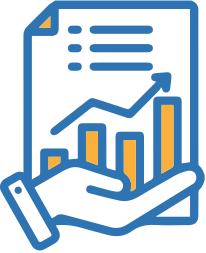Using Data-Driven Decision Making For Sales And Marketing
Data-driven decision making is a process in which data is used to come to a decision or to identify options instead of simply making a decision based on general observations or intuition. Decision-makers who use the data available will be able to make more informed decisions and reduce the risk of making poor decisions that could hurt the company.
The Benefits Of Data-Driven Decision Making In Sales And Marketing Strategies
Businesses that aren’t using data to make decisions that drive their sales and marketing efforts are usually making decisions that are based on guesswork, general observations, assumptions, or pure hope. While collecting and organizing data, and learning how to analyze it, may seem like a lot of work, the advantages of data-driven decision making are more than worth the effort. Here’s why it’s so beneficial:
Irrefutable Source For Change
If marketing or sales results are lower than expected, then change is often needed to turn things around. Without data, you’re forced to guess what changes are needed and hope that you guessed right. Using data, you will be able to identify what is causing your results to be poor and in turn allow you to make decisions that will actually address the issues. Relying on your data takes the guesswork out of implementing changes to your marketing and sales strategies.
Baseline To Compare Results
With data, you will be capable of measuring results over time. This allows you to compare the results of various tactics or to determine whether results have been improving or not over a specific period. Your historic data and ability to compare data will allow you to make decisions based on whether results were good or bad, something that can be difficult to determine without a baseline to compare to. Decision-makers who don’t have such data end up judging results and making decisions based on gut feelings instead.
SMART Goal Setting
Setting goals can be difficult without the use of data. Not only is it difficult to actually set a goal, but you can’t really identify whether you achieved the goal without data to back up your results. Through the use of data, you’ll be able to set SMART (Specific, Measurable, Achievable, Realistic, and Timely) goals.
For example, using the data you’ve collected, you might notice that your current landing page is converting at 2.4 percent; however, other landing pages are converting at a higher rate of 3.6 percent. When comparing these landing pages, you may notice that the higher converting page uses a shorter form. The decision you might then make is to shorten the form on your lower converting landing page. The SMART goal in this instance could be to:
- Shorten the form by two fields for a period of 90 days with the goal of raising the conversion rate by at least 25 percent (from 2.4 percent to 3.0 percent).
Such SMART goals cannot be set or measured without the use of data.
Get A Better Understanding Of Your Customers
Assuming you know who your audience is and what their needs are is generally a mistake, especially when you probably have a significant amount of customer data that you can use to better understand them. Not only do you have the information that you’ve collected from forms that were submitted, the feedback that they’ve provided, or from their interactions with your marketing and sales representatives, but you can also use behavioral data to better understand what customers are looking for.
Customer data can be used to personalize your interactions, which will help to build trust more effectively. For instance, by using the data you have on your customers, you can create detailed buyer personas that you can use to guide your marketing efforts, such as content creation. Your customer data can also be used to segment your email list, making it easier to nurture your leads more effectively by sending them more personalized content.
Manage Sales And Marketing Efforts With Confidence And Supporting Data
Deciding where to invest your resources can be difficult without data. You want to be confident in the decisions you make. For example, if you’re comparing two different lead sources in order to decide which one to invest more heavily in, you’ll only compare the results if you’re not applying data-driven decision making. However, results can be misleading and don’t always tell the whole story.
Maybe the first lead source converts customers at 20 percent, while the second converts customers at 35 percent. At first glance, investing resources into the second lead source makes the most sense since it converts the most customers. However, if you actually look into the data, you might find that although the second lead source converts more customers, it may be costing $50,000 more on average per year than the first lead source. If you’re using data to help make your decision, then you’ll be able to calculate which lead source will provide you with the greater ROI, allowing you to come to a decision that will be supported by your data.
Proactive Decision Making For Marketing And Sales
Analyzing your data will allow you to identify historic patterns, which can help you to predict future trends. For example, if you notice that a lead source has been trending downwards for a three-year period, then you can assume that this trend is only going to continue to decline in the future. If you’re heavily dependent on this lead source to make your pending number, then you can proactively shift your efforts to a different lead source before the numbers from your original lead source decline too much. By predicting future trends, you can avoid potential problems as well as identify better opportunities.
Common Challenges Of Data-Driven Decision Making
As beneficial as it is to base your decision making on your data, it’s a lot easier said than done. Relying on your data to make better decisions comes with its own set of challenges. The inability to identify these challenges and plan for them or to overcome these challenges if they exist can compromise your efforts to make effective data-driven decisions. In fact, these challenges can cause you to make poor decisions, which can have a negative impact on your marketing and sales tactics. We’ve compiled some of the common challenges that you will need to avoid or overcome to ensure that your data-driven decision-making capabilities aren’t hampered.
A Lack Of Infrastructure And Tools
Actually gathering the data can be a challenge since you will need to have the right infrastructure and tools in place. Many businesses will implement a CRM to collect, gather, and organize their customer data in one centralized location. Once you do have a solution for collecting and organizing data, you will also need tools that will analyze and visualize your data so that it will be useful to you.
Poor Quality Data
One of the big challenges of data collection is making sure that your data isn’t of poor quality. Issues such as duplications, inaccuracies, lack of consistency, and a lack of completeness can all affect the quality of your data. Data that’s not up-to-date or that’s obsolete can cause serious problems as well. Inaccurate or irrelevant data will often directly lead to poor decision making.
Siloed Data
Siloed data occurs when different data sources aren’t properly integrated with one another. For example, if your marketing team’s data isn’t combined with your sales team’s data. This can compromise the quality of your data. For example, your marketing team may be missing valuable data on a customer that your sales team has, thereby limiting their ability to make more informed decisions. Ensuring that there are no data silos will help ensure that everyone in your organization has access to the same data.
A Lack Of Organization-Wide Buy-In
Make sure that everyone across your organization buys into data-driven decision making, especially when it comes to key players. When certain individuals or teams don’t buy-in, they may not enter the data that you need in order to analyze the full scenario. As such, making sure that everyone is on the same page is vital to the effectiveness of your ability to collect and analyze accurate data.
Not Knowing How To Use Your Data
Even if you’re collecting data that is accurate, another issue that might come up is actually knowing how to leverage your data to help make key decisions. Not knowing what to do with the data you have or what actions you need to take based on your analytics defeats the purpose of data-driven decision making.
Being Unable To Identify Actionable Data
Deciding what data to track and analyze means deciphering what data will be actionable in the long run. If you’re collecting and analyzing data that don’t apply to the key decisions you need to make in the future, then you won’t be able to make data-driven decisions.
Too Much Focus On Data
While your data can help you make more informed decisions, it’s important not to become overly reliant on your data. There are going to be cases in which a human element is required to make the best decision. In such cases, focusing solely on data can be limiting. A balance between data and creativity is needed in order to attain the best possible results.
How To Implement Data-Driven Decision Making
The use of data is supposed to allow you to make more informed decisions that will help you achieve specific marketing and sales goals. However, in order to implement data-driven decision making, you will need to go through a lengthy process of collecting data, extracting the data, formatting the data, analyzing the data, and then visualizing it. This process doesn’t even include overcoming the challenges that commonly stand in the way of effective data-driven decision making.
With all that in mind, it’s still worth every effort required to implement data-driven decision making since the benefits are so significant. These are the steps to take toward making marketing and sales decisions that are based on accurate and relevant data.
Determine Your Objectives
Establish your objectives early on. This will allow you to define the proper KPIs (key performance indicators) and track and analyze the data that you need to make better decisions. Without clear objectives, you’ll have trouble determining how you should take action based on the data you have.
Identify Your Data Sources
Businesses often don’t realize how much data they actually have access to. You will need to identify a list of data sources from which you will extract your data so that you can coordinate information from these different sources. These data sources can include your website, your social media pages, your online advertising platforms, your email campaign, your feedback forms, and more.
Create The Infrastructure To Capture The Data
A CRM solution will allow you to store and organize your data in a centralized location where it can be easily accessed by your sales and marketing teams. There are many different CRM solutions to choose from. Some factors to consider when choosing a CRM solution include how user-friendly the platform is, how many integrations it offers, how customizable the features are, what types of features it offers, and how much the solution will cost.
Collect Your Data
Because you’ll want to collect data from multiple data sources, make sure that you choose a CRM solution that offers a variety of integration options. Take note of all data sources and software solutions that you are currently using and make sure the CRM you implement is capable of integrating with those sources and solutions. This will help ensure that you’re able to analyze all of your data and not just some of it and help to prevent data silos as well.
Data Entry Accountability
Because the effectiveness of data-driven decision making is based on the quality and completeness of your data, be sure that everyone who is responsible for data entry throughout your organization understands the process and buys in. This also means that you need to define standards for data entry. For example, if one person in one department is spelling out numbers while another person is typing out numerals (for instance, five versus 5), their data isn’t going to match even if they’re entering the same data on the same customer.
Clean Your Data
Despite attempts to standardize data entry and to prevent data silos, there may still be inaccuracies in your data. Because of this, your data needs to be cleaned before it can be analyzed. Cleaning data involves going through your data after it’s been collected and either correcting or removing data that is incorrect, irrelevant, or incomplete.
Analyze Your Data
Your data won’t offer value until it’s analyzed. It’s the only way to gain meaningful and actionable insight that you can use to make better decisions. You will need to implement analytics tools in order to analyze your data. There are many tools to choose from, all of which perform different types of analysis. For example, you can perform statistical analysis, diagnostic analysis, predictive analysis, and more.
Use Dashboards And Reports To Visualize Data
BI (business intelligence) solutions allow you to create dashboards and reports so that you can visualize your data. Through the use of dashboards, you can access the KPIs you defined in real-time to make quick and accurate decisions. Visualizing your KPIs through dashboards and reports also makes them easier to read and understand.
Action Your Data
When choosing your KPIs, begin with small and well-defined KPIs. If you’re tracking and analyzing too much data, it can become difficult to take action as a result of being overwhelmed by the options your data presents. When you have so many options, it can hurt your confidence in your ability to make the right decision. If you begin with smaller and more defined data, you’ll be able to make more focused decisions that will improve your results.
Drive Sales And Marketing Success With Data-Driven Decision Making
Tracking and analyzing data can help monitor the performance of marketing and sales strategies, identify patterns and trends, and make confident decisions quickly and proactively. Data-driven decision making can help promote your company’s growth, which is why it’s well worth the time and effort required to implement a reliable data collection, cleaning, analysis, and visualization process.















